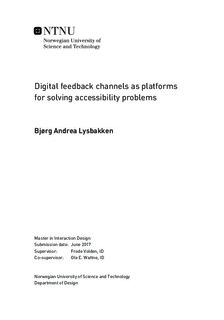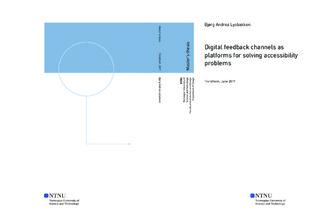| dc.description.abstract | Society is facing continuous challenges regarding accessibility in information and communication technology (ICT), including mobile applications. Solutions fail to accommodate the diverse abilities and requirements of different users, depriving many people of possibilities to take full advantage of digital services and products.
Based on the present state of ICT there is a need to explore new methods for how to develop widely inclusive solutions. Digital feedback channels represent an opportunity for communication between end users and companies to solve issues with products and services. However, research seems to be lacking on the use of such channels for accessibility purposes.
This thesis investigates how effectively two digital feedback channels, emails and App Store reviews, function as platforms for solving accessibility issues in mobile applications. More specifically, the study focuses on problems for blind persons using the screen reader VoiceOver to interact with mobile content. A field experiment was conducted, in which a sample of iOS applications from Norwegian top lists was evaluated for the purpose of finding accessibility problems. Feedback concerning 50 problems in 50 separate applications was sent in via emails or App Store reviews. The applications were re-tested after 30 days to document the effect. As part of interviews performed, the study also looked into habits, preferences, and experiences of persons in the user group, with regards to sending feedback about accessibility problems through digital channels.
Findings from the field experiment indicate that sending feedback through emails and App Store reviews currently has a minimal effect on solving VoiceOver related accessibility problems in mobile applications. As the sample was limited to a selection from the most popular iOS applications in Norway within certain categories, the results are considered likely to be more generalizable to this specific subpopulation than to the general population of mobile applications. Factors such as time, type and severity of problems and feedback formats, formulation and quantity could potentially influence the results and therefore be subject to further research. Additional findings from the interviews suggest that there are challenges which should be further investigated regarding how persons in the user group experience to employ digital feedback channels for communication about accessibility problems.
Collaboration between end users and companies through digital feedback channels such as emails and App Store reviews could be part of the solution for achieving increased accessibility in mobile apps and other ICT solutions. Further studies should be done on the potential of using these channels for such purposes, and how to utilize this potential in more effective ways. | |

